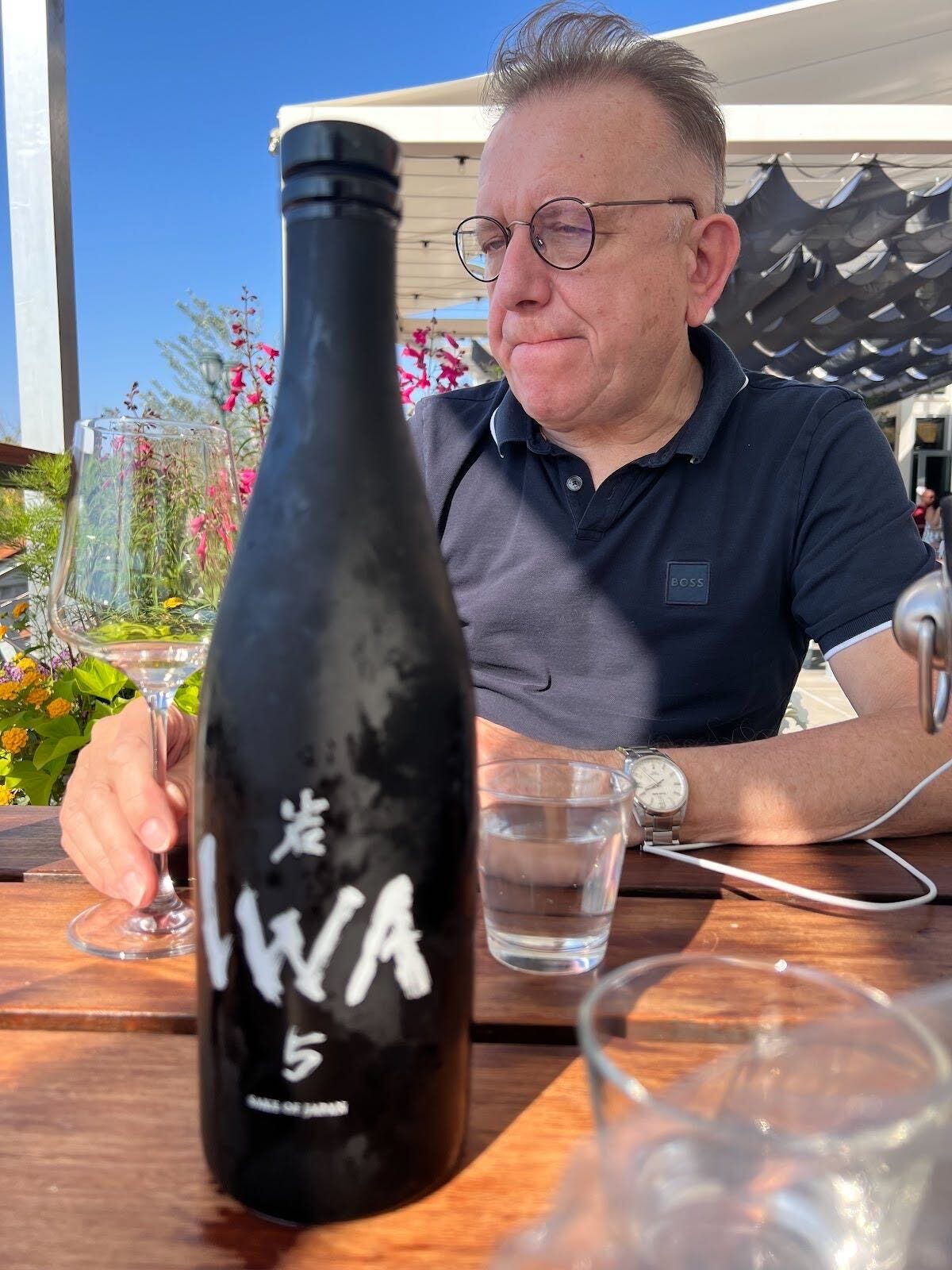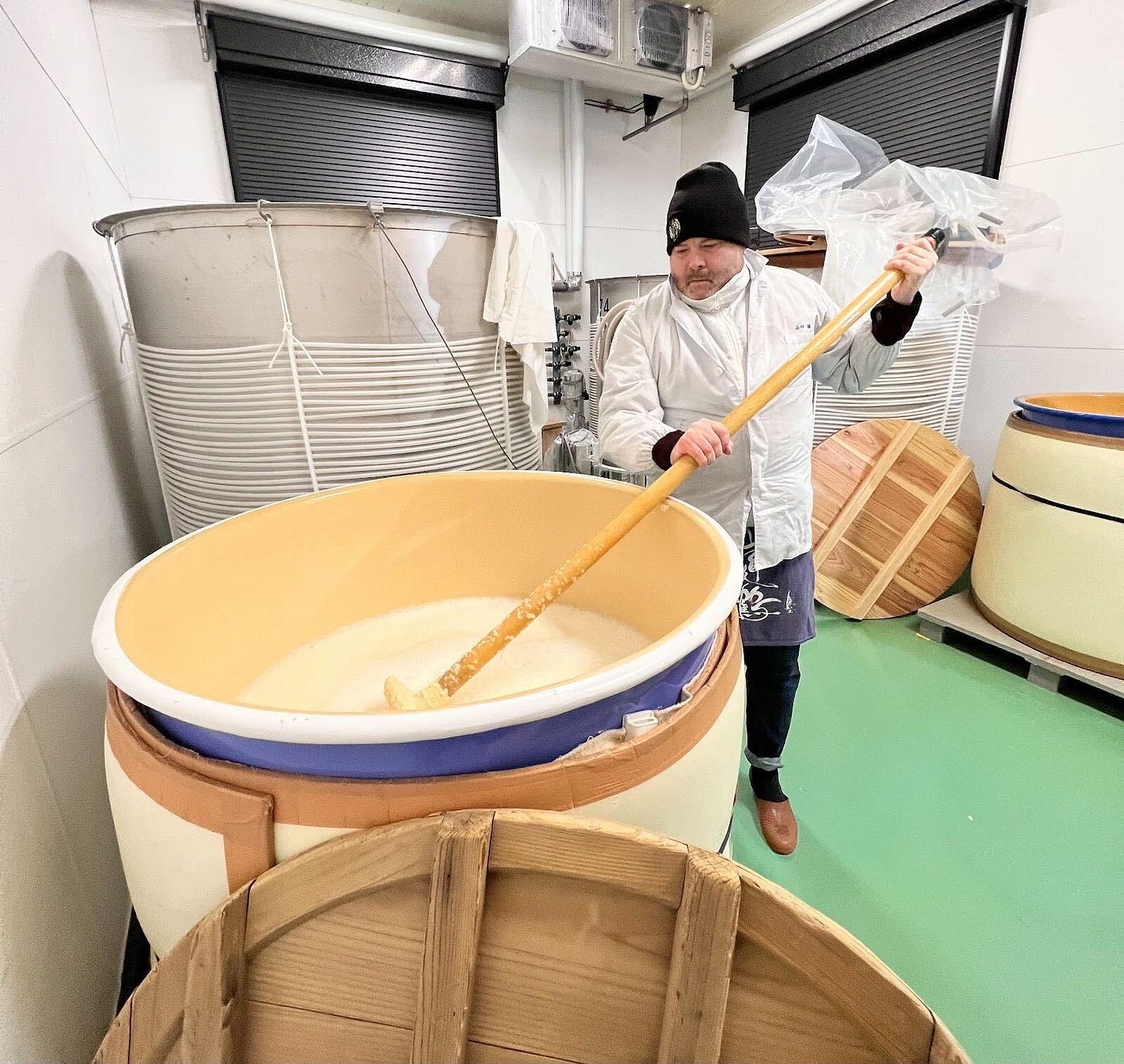NAPA, Calif. — Beyond the rice-milling classifications, several other techniques used by the toji (brewmaster) and kurabito (brewery workers) have a great impact on the final product. Here are the most relevant variations.
The words yamahai and kimoto refer to the old method of sake fermentation. These two styles of production require a longer fermentation period, upward of a month. While they are time-consuming, opting for yamahai or kimoto results in a celebrated complexity and texture that are hard to achieve with the shorter modern fermentation, sokujo. The latter produces clean, consistent and elegant styles with control and efficiency.
One of my go-to kimoto producers in the market is Tsuchida. I got to visit them recently, and I’m a huge fan of their minimal-intervention approach to sake-making that creates thought-provoking sakes. Their Tsuchida “ White” Kimoto Junmai Namachozo, Gunma ($50 720ml) is savory, creamy and enchanting.
The old methods add richness and depth, just as oak influences wines such as Reserva Tempranillo from Rioja or Riserva Nebbiolo from Barolo, where Sokujo delivers a more focused and delicate style like unoaked Langhe Nebbiolo and Italian Pinot Grigio.
The term genshu means undiluted. The sake can reach high levels of alcohol by volume, upward of 20-plus but not always as elevated. There is no water back as a considerable amount of sakes experience.
In essence genshu relies on the alcoholic conversion and caps at the level at which the yeast stops working, capturing more flavor and generosity. Like Sauvignon Blanc from the Loire Valley, it tends to dance around 12.5% alcohol versus a Napa Sauvignon Blanc, which sits around 14.5%, delivering more horsepower.
Harada Gengetsu Junmai Ginjo Genshu Muroka, Yamaguchi ($45 720ml) is a breathtaking sake that packs a memorable experience. Layered complexity with its dried stone fruit, ginger snap, lavender seed and dried herb makes for an epic ride. Made by an all-woman team in the south of Japan, it is simply delicious.
Several terms refer to the unfiltered question. Doburoku is an ancestral method of sake production that produces thickness and full flavor. This category is making a huge impact not only in Japan but also abroad. Like a natty wine, it is unapologetic and memorable.
Nigori, the most common cloudy style, is produced with all the premium sake standard practices but retains some level of rice and yeast particles that give it texture and flavor. Ranges of nigori are vast, with sweeter examples leading in popularity with a style that resembles a sweet Prosecco.
A tricky one is muroka. The literal meaning is the absence of charcoal filtration that the brewery decided to skip in order to retain more complexity and concentration. It is clear but sometimes exhibits a golden-copper tone and a light haze. In terms of wines, it is similar to unfiltered examples such as oaked Chardonnay or Napa Cabs that are clear but can exhibit a slight color variation and more impact on the palate.
Namazake refers to unpasteurized sake. It is fragile and unprotected, so temperature fluctuations and sunlight will have a negative impact and basically spoil it. Once rare in the United States, these styles are gradually gaining traction, in part due to the producers trusting shipping, handling and serving practices and also to having an educated sake-drinking audience that seeks and celebrates this unique expression.
Namas are rambunctious creatures that explode with aromatics and are gifted with an electric vibrancy on the palate. Namazake is the bright Instagram filter that pops all visuals. The closest wine reference is Beaujolais Nouveau, which is produced via carbonic maceration that delivers a fruity explosion to the senses.
Another important designation in sake is Koshu, which has a couple of meanings. Koshu is a white grape variety claimed to be native to Japan and a gift from Buddha a millennium ago. The second and more relevant meaning is aged sake. To earn the word “Koshu” on the label, a sake must be held for a minimum of three years. The vessel varies, but stainless steel, porcelain and glass containers are utilized to age the sake.
The result is fascinating. Richness, nuttiness, marzipan and plenty of umami dance in the glass, depending on the aging. When you get into the 20- or 30-plus years it results in port- or cognaclike personalities with walnut-shell aromatics, dried stone fruit and consommé notes.
The practice of aging and blending sake has always been present, but it is gaining traction in Japan and abroad. Some of my favorite styles deliver a Manzanilla Sherry-like structure and floral notes.
Aside from the many variations in production, regionality plays a dramatic role in the styles. Think about comparing Japan and sake to Italy and wine. The wines of the south, such as Sicily and Campania deliver a strikingly different experience based on the grapes, soils and seafood influence in the cuisine. The wines produced in the northern regions of Piemonte and Friuli are based on the elevation, game, dairy-driven diets and varieties planted.
The same goes for Japan. Sake from the northern islands of Hokkaido or Akita offers a departure from a Wakayama or Kumamoto sake from the south due to water mineral content, rice strains, yeast selection and culinary preferences that range from pristine shellfish in the north to a richer, gamier, pork-driven fare in the south.
Regarding avant-garde styles and experimentation, a wave of young, renegade Tojis are pushing the envelope. Much of the innovation is coming from bridging the gap between wine and sake for several reasons. One is to appeal to a wider audience. With a deeper sense of sake pairings, producers are betting on the marriage with food as diners and sommeliers celebrate the opportunity.
Sakes that reminisce of Vouvray from the Loire, German Riesling, Amontillado Sherry and even Sauternes are turning heads and making new fans every day, which is worth celebrating.
Imayotsukasa IMA from Niigata ($40 720ml) offers a bridge between wine and sake with a floral bouquet, Meyer lemon rind, echinacea and a kiss of honey balanced with excellent acidity akin to Spatlese-level Riesling.
Assemblage in sake has become a topic of conversation in Japan and abroad. While it isn’t a common practice, blending a variety of sakes to create a blend has gained steam.
Two sakes in this category stand out. Kinmon Akita Assemblage from Akita prefecture ($50 720ml), President Takashi Sasaki, is a blended and mature sake that delivers an award-winning and globally recognized style.
Also taking the world by storm is IWA Junmai Daiginjo ($190 720ml), with Richard Geoffroy (a former Dom Perignon winemaker) behind it. After a long and impactful career in the Champagne world, Geoffroy shifted his focus to sake, setting up shop in Toyama and delivering a unique experience.
Other styles and terms to know are Awa sake, which refers to Methode Champenoise-produced sake. This is a newer category and certainly worth seeking. Tarusake refers to cedar-barrel-influenced sake with a spicy, woodsy taste.
The world of sake offers a plethora of styles that depend on the ingredient selection, technique, regionality and experimentation that combine to intrigue increasing numbers of seasoned sake drinkers and curious novices alike.
Eduardo Dingler is a Napa Valley-based wine writer, wine judge and sake aficionado. Follow Eduardo’s sake journey @sakedrinker









Eduardo always offers great insight and subject matter expertise to his writings. He makes complex content easy to read and understand.